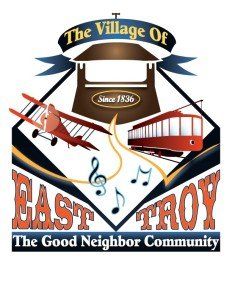Communities
Settled in 1836 by Henry & Samuel Phoenix, Delavan was named in honor of a noted temperance leader in New York. Originally intended to be a temperance colony, all deeds to property given by the Phoenix brothers contained a clause prohibiting the sale of intoxicants on the property. In 1837, a post office was established, clearing the way for a saw and grist mill to be erected a few years later.
During the mid 1800’s Delavan had one of the most used highways, extending east to Racine and west to Janesville. This road was planked from Racine to Delavan, and was one of the leading thoroughfares of its time.
The Wisconsin School for the Deaf was established in Delavan in 1852, after an early settler of the town of Darien, Ebenezer Chesebro, brought a petition signed by approximately 100 residents of the county, for a school establishment in Wisconsin, for instruction of deaf children. In 1852, the state’s appropriations for the school were one thousand dollars for building and five hundred dollars a year for administration.
1855 marked the year that Delavan incorporated into a village, and shortly thereafter, the Racine and Mississippi Railroad Company built tracks through the then village. In 1861, a pump factory was created, which turned out approximately 5,000 wooden pumps a year. Later this factory was retooled to create iron pumps and wind mills.
In 1903, an industry was started, which brought great value to the economic development of the then city. Globe Knitting Mills, later to become the Bradley Knitting Company, grew into a large industry with a chief product of woolen sweaters. This factory employed approximately 100 people in 1910 and ballooned to over 400 during WWI.
Links
East Troy
The area of East Troy was first settled in 1836, when a man named H. Roberts began construction of a saw mill on the shores of Honey Creek. The area grew very rapidly and the next four years saw the establishment of a hotel, general store, blacksmith, chapel, school, post office, doctor, lawyer, and justice of the peace.
East Troy was originally known as Troy after a place called Troy, New York, from where many of the settlers originated. It was decided, during 1843, that Troy was too large of an area for one township, and the territory of Troy was split by the state legislature. The western part was renamed Meacham, after an early settler and the eastern part remained Troy.
This arrangement was deemed unsuitable to the western portion, including Jesse Meacham, for which the area was named. Meacham set out for the capital to reclaim the name of Troy. There is a legend that Jacob Burgit, an early settler and representative of the eastern territory, heard of Meacham’s trip, and set out for the capital to argue his own case for keeping the name of Troy for the east. However, Burgit arrived too late, and the the name of Troy was given to the west. The east was then renamed to East Troy, as it remains today.
The village of East Troy was officially platted in 1847. All of the land south of main street belonged to Burgit, who purchased the claim in 1837, built the saw mill, and later built a grist mill, which helped to develop flourishing business in the area. Austin McCracken owned all the land north of the Main Street. McCracken came to East Troy in 1836, and built the first public inn in Walworth County. This public inn was built of log, and was located in the same site where the East Troy house now stands.
In an effort to stimulate growth in the community, Burgit and McCracken offered a free lot to anyone who would build there. They set aside land for churches, a public square, and parks. Today, the village square is a centerpiece for the community. The square hosts festivals, band concerts, and any visitors who wish to partake in its historic beauty.
Settled in the early 1800’s, Elkhorn was given its name by Colonel Samuel Phoenix, who spotted a rack of elk antlers caught in a tree and proclaimed the area as “Elk Horn”. When founded, Elkhorn was a business center of a rich farming region. At that time, it did not acquire any manufacturing because of its location, as it sits in the exact center of Walworth County, it was off the main lines of communications, thus holding out fewer advantages than other cities in the area. In 1856, the Racine and Mississippi Railroad passed through Elkhorn, causing a boom in the then village.
Due to its location, Elkhorn was designated as the county seat in 1846, serving as the host community for governance and justice, financial and service organizations, and facilities and events. Between 1849 and 1857 the population grew from 539 to upwards of 1,500. In 1851, Elkhorn became home to the Walworth County Fair, deemed as one of the best county fairs in the nation. Today the event draws more than 100,000 visitors to the City. By 1920, Elkhorn was home to one major manufacturing company, the Frank Holton Company, makers of brass band instruments, which employed around 150 people. In 1964, the Holton Company was bought by Leblanc, a division of Conn-Selmer.
Lake Geneva
Lake Geneva’s history revolves around its name sake Geneva Lake. The first settlers to Lake Geneva choose the site to build the county’s first flour mill at the outlet of Geneva Lake to the White River. In 1840, a major road and stage route between Kenosha and Beloit was established through Lake Geneva and in 1844, the settlement became an incorporated village.
Manufacturing was never an important industry in Lake Geneva at that time. Its reputation as a place that rests upon a beautiful lake, and its proximity to Chicago attracted many wealthy men who built, on the south shore particularly, some of the most expensive summer homes found in Wisconsin. After the Chicago Fire, many of the wealthy Chicago families moved into their summer homes while Chicago was rebuilt, causing a large economic boom in the City.
Referred to as “The Newport of the Midwest” or “The Hamptons of the Midwest” the area boasts a rich history of old Chicago wealth. Today Lake Geneva draws individuals from around the world who come to view the multi-million dollar mansions lining the shores and learn about the history that has made this city synonymous with fame and wealth.
Whitewater is located in Southeastern Wisconsin, straddling the Northwest corner of Walworth County and the Southern section of Jefferson County. With a population of over 14,200, of which approximately 11,500 residents live in Walworth County with the rest residing in Jefferson County, it is the largest City in Walworth County.
Settled in 1836, the City was given its name because of the white sand located in the beds of the local creeks and brooks. In 1852 the population of the then town of Whitewater was about 500 and was starting to grow rapidly due to the newly built railroad tracks installed by Milwaukee and Mississippi Railroad (now The Milwaukee Railroad). In 1858 a portion of the Town of Whitewater incorporated into a Village with a population of approximately 2,500. At this time, an inventor by the name of George Esterly, who had perfected the first successful American harvesting machine, made Whitewater the center of his manufacturing operations, and for many years this plant was the largest employer in Whitewater with about 400-500 employees.
In 1860, the Winchester and Partridge Manufacturing Company started to manufacture plows and later wagons in Whitewater employing between 150 to 200 men. The company sold its wagons throughout the US and Canada (some through Montgomery & Ward), and quickly became known as “Whitewater Wagons” for their superior workmanship and the company’s reputation.
The University of Wisconsin-Whitewater became Wisconsin’s second public college on April 21, 1868 when it opened its doors to 39 students taught by nine faculty members. By 1880, George Esterly, with a thriving harvesting manufacturer, also established a furniture company in Whitewater which employed 75 persons in the then village of 3,621. With all of this commerce and a growing population, Whitewater incorporated into a City in 1885.
In the early 1890’s, the City of Whitewater was booming, but 1893 brought on many challenges for the city. George Esterly moved his manufacturing facilities to Minnesota, leaving approximately 575 residents unemployed. The population in Whitewater dropped significantly from its height at that time of 4,359 to 3,108 in 1905. Today Whitewater is again a thriving city with over 14,000 residents, a University that enrolls over 11,000 students a year, and a newly created Technology Park, which was designed to leverage the knowledge base within the University to help foster innovation and job creation within the community.








